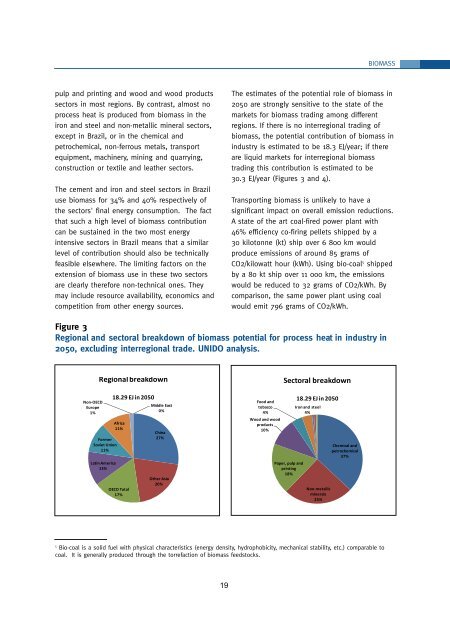Renewable Energy in Industrial Applications â an ... - Unido
Renewable Energy in Industrial Applications â an ... - Unido
Renewable Energy in Industrial Applications â an ... - Unido
Create successful ePaper yourself
Turn your PDF publications into a flip-book with our unique Google optimized e-Paper software.
BIOMASS<br />
pulp <strong>an</strong>d pr<strong>in</strong>t<strong>in</strong>g <strong>an</strong>d wood <strong>an</strong>d wood products<br />
sectors <strong>in</strong> most regions. By contrast, almost no<br />
process heat is produced from biomass <strong>in</strong> the<br />
iron <strong>an</strong>d steel <strong>an</strong>d non-metallic m<strong>in</strong>eral sectors,<br />
except <strong>in</strong> Brazil, or <strong>in</strong> the chemical <strong>an</strong>d<br />
petrochemical, non-ferrous metals, tr<strong>an</strong>sport<br />
equipment, mach<strong>in</strong>ery, m<strong>in</strong><strong>in</strong>g <strong>an</strong>d quarry<strong>in</strong>g,<br />
construction or textile <strong>an</strong>d leather sectors.<br />
The cement <strong>an</strong>d iron <strong>an</strong>d steel sectors <strong>in</strong> Brazil<br />
use biomass for 34% <strong>an</strong>d 40% respectively of<br />
the sectors' f<strong>in</strong>al energy consumption. The fact<br />
that such a high level of biomass contribution<br />
c<strong>an</strong> be susta<strong>in</strong>ed <strong>in</strong> the two most energy<br />
<strong>in</strong>tensive sectors <strong>in</strong> Brazil me<strong>an</strong>s that a similar<br />
level of contribution should also be technically<br />
feasible elsewhere. The limit<strong>in</strong>g factors on the<br />
extension of biomass use <strong>in</strong> these two sectors<br />
are clearly therefore non-technical ones. They<br />
may <strong>in</strong>clude resource availability, economics <strong>an</strong>d<br />
competition from other energy sources.<br />
The estimates of the potential role of biomass <strong>in</strong><br />
2050 are strongly sensitive to the state of the<br />
markets for biomass trad<strong>in</strong>g among different<br />
regions. If there is no <strong>in</strong>terregional trad<strong>in</strong>g of<br />
biomass, the potential contribution of biomass <strong>in</strong><br />
<strong>in</strong>dustry is estimated to be 18.3 EJ/year; if there<br />
are liquid markets for <strong>in</strong>terregional biomass<br />
trad<strong>in</strong>g this contribution is estimated to be<br />
30.3 EJ/year (Figures 3 <strong>an</strong>d 4).<br />
Tr<strong>an</strong>sport<strong>in</strong>g biomass is unlikely to have a<br />
signific<strong>an</strong>t impact on overall emission reductions.<br />
A state of the art coal-fired power pl<strong>an</strong>t with<br />
46% efficiency co-fir<strong>in</strong>g pellets shipped by a<br />
30 kilotonne (kt) ship over 6 800 km would<br />
produce emissions of around 85 grams of<br />
CO2/kilowatt hour (kWh). Us<strong>in</strong>g bio-coal 5 shipped<br />
by a 80 kt ship over 11 000 km, the emissions<br />
would be reduced to 32 grams of CO2/kWh. By<br />
comparison, the same power pl<strong>an</strong>t us<strong>in</strong>g coal<br />
would emit 796 grams of CO2/kWh.<br />
Figure 3<br />
Regional <strong>an</strong>d sectoral breakdown of biomass potential for process heat <strong>in</strong> <strong>in</strong>dustry <strong>in</strong><br />
2050, exclud<strong>in</strong>g <strong>in</strong>terregional trade. UNIDO <strong>an</strong>alysis.<br />
Regional breakdown<br />
Sectoral breakdown<br />
Non-OECD<br />
Europe<br />
1%<br />
Former<br />
Soviet Union<br />
11%<br />
Lat<strong>in</strong> America<br />
13%<br />
18.29 EJ <strong>in</strong> 2050<br />
Africa<br />
11%<br />
OECD Total<br />
17%<br />
Middle East<br />
0%<br />
Ch<strong>in</strong>a<br />
27%<br />
Other Asia<br />
20%<br />
Food <strong>an</strong>d<br />
tobacco<br />
4%<br />
Wood <strong>an</strong>d wood<br />
products<br />
10%<br />
Paper, pulp <strong>an</strong>d<br />
pr<strong>in</strong>t<strong>in</strong>g<br />
18%<br />
18.29 EJ <strong>in</strong> 2050<br />
Iron <strong>an</strong>d steel<br />
4%<br />
Non-metallic<br />
m<strong>in</strong>erals<br />
25%<br />
Chemical <strong>an</strong>d<br />
petrochemical<br />
37%<br />
5<br />
Bio-coal is a solid fuel with physical characteristics (energy density, hydrophobicity, mech<strong>an</strong>ical stability, etc.) comparable to<br />
coal. It is generally produced through the torrefaction of biomass feedstocks.<br />
19

















